Click On Image
For Full Size Image |
Size |
Image Description |
Contributed
By And/Or Copyright |
1942 — 1947
|
Name
|

NS0209bc |
107k |
CV-9 was named Essex to commemorate the previous naval service
of other US vessels that had borne the name. Essex is a town and county in Massachusetts (NS0209bc).
Previous US warships named Essex:
- A frigate.
- An ironclad steamer.
- A wooden screw steamer.
(Map courtesy of Google Maps.) |
NavSource |
The Early Years — World War II
|

NS0209ab |
532k |
USS Essex (CV-9), World War II.
Overhead plan and starboard profile meticulously drawn by John Robert Barrett. |
Navy Yard Associates |

NS020938a |
59k |
Essex christening, Friday, 31 July 1942. Mrs. Artemus Gates,
wife of the Assistant Secretary of the Navy for Air, Sponsor. |
S. Dale Hargrave |

NS020938b |
42k |
Mrs. Gates christening Essex. |
S. Dale Hargrave |

NS020938c |
65k |
Essex sliding into the James River. |
S. Dale Hargrave |

NS020938 |
91k |
Essex just after launch, July 31st, 1942 at Newport News
Shipbuilding.
|
Steve Whitby |

NS020938d |
931k |
"NEW NEST FOR U.S. NAVY PLANES—Flanked by craft of sea and air, Uncle
Sam's newest aircraft carrier Essex—the first to be launched since Pearl Harbor—rides
the waves after sliding down the ways at Newport News, Va."
The Wilmington Morning Star/The
Sunday Star-News, Wilmington, N.C., Sunday, 9 August 1942. |
Chronicling
America,
via Michael Mohl |

NS020939e |
132k |
Essex at inclining, 19 December 1942. Quarter port, bow.
Newport News Shipbuilding & Dry Dock Company photo. |
Ed Zajkowski |

NS020939 |
112k |
Essex at inclining, 19 December 1942, looking starboard to
island. Newport News Shipbuilding & Dry Dock Company photo. Notice she hasn't had her SK and
SC air search radar and Mk 4 fire control radars added yet. |
Original photo submitted by Steve Whitby.
Pieter Bakels |

NS020939d |
170k |
Essex at inclining, 19 December 1942. Flight deck, looking
forward. Newport News Shipbuilding & Dry Dock Company photo. |
Ed Zajkowski |
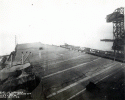
NS020939b |
188k |
Essex at inclining, 19 December 1942. Flight deck, looking
aft. Newport News Shipbuilding & Dry Dock Company photo. |
Original photo submitted by Pieter Bakels.
Replacement photo by Ed Zajkowski. |

NS020939a |
100k |
Essex at inclining, 19 December 1942, looking forward. Newport
News Shipbuilding & Dry Dock Company photo. |
Pieter Bakels |

NS020939c |
108k |
Forward 5"/38 gun mounts and island of Essex (CV-9), 19 December
1942. |
Gerd Matthes, Germany |

NS0209ad |
88k |
Essex (CV-9) on sea trials off the coast of Virginia, December
1942. |
Gerd Matthes, Germany |

NS020941 |
101k |
Right after commissioning, Dec. 31st. 1942. |
Steve Whitby |

NS020940 |
101k |
Essex leaving Newport News for Norfolk Navy yard, Dec. 31st.
1942. |
Steve Whitby |

NS020940a |
489k |
Uncropped version of photo NS020940, above. (Please
disregard what is printed on the photo.) |
Ron Titus |

NS0209dd |
202k |
Essex — CV-9. From US Naval Ships & Aircraft
(ONI 54-R), condensed and printed for FM 30-50, NAVAER 00-80V-57 (Recognition Pictorial Manual of
Naval Vessels). Supplement 2 - 1 April 1942. |
Gerd Matthes, Germany |

NS0209dda |
220k |

NS0209cj |
84k |
USS Essex (CV-9). View of island. Date and location unknown. |
David Buell |

NS020983 |
127k |
Official U.S. Navy photograph of USS Essex (CV-9). Aerial, broad
side on port bow view taken at Hampton Roads, Va., and dated 1 February 1943. Photo from the U.S.
Naval Photographic Center, U.S. Naval Station Anacostia, Washington, D.C. (serial number USN 36007). |
Robert M. Cieri |

NS020983a |
43k |
Port broadside photo of USS Essex (CV-9) on 1 February 1943,
one month after being commissioned. The ship is painted in Measure 21 camouflage scheme and is completing
shakedown cruises off Norfolk Navy Yard before leaving for the Pacific War Zone.
Photo from the Naval Recognition Manual files (1943–1945). |
Mike Green |

NS020968 |
67k |
USS Essex (CV-9) at Hampton Roads, Norfolk, VA, 3 February 1943,
just one month after commissioning. US Navy photo. |
Robert Hurst |

NS0209bs |
390k |
Commander Fitzhugh Lee prior to first take off from USS Essex
(CV-9), 16 February 1943.
Official U.S. Navy Photograph, now in the collections of the National
Archives and Records Administration (NARA), # 80-G-228006. |
NARA |

NS020972 |
59k |
USS Essex (CV-9) underway in the Pacific, date unknown (probably
1943—thanks to Tracy White—.) She is camouflaged
in Measure 21. |
Robert Hurst |

NS020913 |
535k |
Scene on the flight deck, looking aft from the carrier's island during her
shakedown cruise, 20 March 1943. Planes parked on deck are F6F-3 Hellcat fighters (in foreground,
with wings folded) and SBD-4 Dauntless scout bombers.
Official U.S. Navy Photograph, now in the collections of the National
Archives and Records Administration (NARA), # 80-G-K-698. |
Scott Dyben
NARA,
via Michael Mohl |

NS020914 |
138k |
Underway at 1615 hrs. during May 1943, in position 37 05'N, 74 15'W,
as photographed from a blimp from squadron ZP-14. Among the aircraft parked on her flight deck
are 24 SBD scout bombers (parked aft), about 11 F6F fighters (parked in after part of the
midships area) and about 18 TBF/TBM torpedo planes (parked amidships).
Official U.S. Navy Photograph, now in the collections of the National Archives (photo # 80-G-68097).
Note: The official caption for this photo gives the location as 37 05'N, 74 15'E,
which is deep inland, in the Wakhan Corridor, Afghanistan. Position 37 05'N, 74 15'W puts Essex
off the coast of Norfolk. (Thanks to William Stevens, who pointed out the error.) |
Scott Dyben |

NS0209cz |
352k |
USS Essex (CV-9) underway from Pearl to operations
in Southwest Pacific area, as part of Task Group (TG) 53.3. USS Guadalupe
(AO-32) is refueling Essex on 1 November 1943.
Photos by Bob Lehman, USS John Rodgers
(DD-574). |
John Chiquoine |

NS0209cza |
243k |

NS013843d |
656k |
Aerial of Pearl Harbor, Territory of Hawaii. Shown: Ship dispersal and docking
areas. Photograph released 12 December 1943.
The battleship at the navy yard pier is the New
Mexico (BB-40) because of the mainmast configuration. Both of her sisters had their primary
air search radar sets on the mainmast at the time. The three battleships nested by Ford Island are
the Tennessee (BB-43), outboard;
Colorado (BB-45) in the middle; and
Pennsylvania (BB-38) inboard, on
the Ford Island side.
Note the two Essex-class carriers off Ford Island: Essex (CV-9)—left—and
Yorktown (CV-10)—right. USS Cowpens (CVL-25)
is seen between and beyond Essex and Yorktown. USS Belleau
Wood (CVL-24) and USS Cabot (CVL-28) can also be seen to the left
and beyond Essex (see also photo NS0209bia). (Special thanks
to Max Stola, who checked the War Diaries to identify all carriers.) |
Partial text courtesy of DANFS.
USN photo #80-G-221100, now in the collections of the National
Archives, courtesy of the National
Museum of the U.S. Navy, courtesy of flickr.com.
Photo & text i.d. courtesy of Richard M. Jensen & Fabio Peña |

NS0209bi |
1.00M |
View from a different angle, as above.
USS Enterprise (CV-6) is the carrier moored slightly to the left and
down from the center of the photo. USS Lexington (CV-16) is in dry dock
#4, to the left and up from the center of the photo. (Special thanks to Max Stola, who checked the
War Diaries to identify all carriers.)
National Archives and Records Administration
(NARA), photo # 80-G-221096. |
NARA |
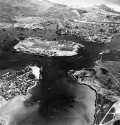
NS0209bia |
870k |
View from a different angle, as above.
The two moored carriers, slightly to the left and down from the center of the photo, are USS Cabot
(CVL-28)—closer to camera—and USS Belleau Wood (CVL-24). (Special
thanks to Max Stola, who checked the War Diaries to identify all carriers.)
National Archives and Records Administration
(NARA), photo # 80-G-221097. |
NARA |

NS0209az |
57k |
Three photographs of plasti-glass windows installed on MK 49
directors aboard USS Essex (CV-9). Included in "Gun
Director Mk. 49 - comments on", sent by the commanding officer (CAPT Ralph A. Ofstie) to the Chief
of the Bureau of Ordnance, January 1944. |
Tracy White, Researcher @ Large |

NS0209aza |
54k |

NS0209azb |
36k |

NS0209bg |
190k |
USS Essex (CV-9) en route to Kwajalein and Operation Flintlock,
25 January 1944, as seen from USS Intrepid (CV-11). Essex,
Intrepid and USS Cabot (CVL-28) formed CTG 58.2, under RADM Alfred
E. Montgomery.
National Archives and Records Administration (NARA), photo
# 80-G-227113. |
Andrew Faltum |

NS0209ar |
374k |
"Typical Ship's Schedule for Day in Combat Zone." 29 January 1944. |
Mark Herber |

NS0209as |
35k |
Air Department Plan of the Day, Thursday, 17 February 1944. |
Mark Herber |

NS0209at |
157k |
Plan of the Day, Tuesday, 22 February 1944. |
Mark Herber |

NS0209ata |
677k |
Task Group 58.2, USS Essex (CV-9), USS Yorktown
(CV-10), and USS Belleau Wood (CVL-24) in combat with Japanese aircraft
on D-Day during the raid on Saipan in the Marianas Islands, 22 February 1944. Taken from USS Essex.
Seen is USS Belleau Wood.
National Archives and Records Administration
(NARA) photo, # 80-218424. |
NARA |

NS0209atb |
871k |
A Japanese aircraft, identified as a Yokosuka D4Y Suisei ("Comet")
reconnaissance bomber (Allied reporting name Judy), seen from USS Essex (CV-9),
as it dived toward the ship on D-Day, 22 February 1944, during raid on Saipan in the Marianas Islands
by Task Group 58.2.
National Archives and Records Administration
(NARA) photo, # 80-218415. |

NS0209atc |
994k |
Barrage of anti-aircraft fire laid down to stop a Japanese torpedo plane on
D-Day raid on the Marianas Islands by Task Group 58.2, 22 February 1944. USS Belleau
Wood (CVL-24), center, photographed from USS Essex (CV-9).
National Archives and Records Administration
(NARA) photo, # 80-218416. |

NS020942 |
113k |
Essex in San Francisco for a refit, April 15th, 1944. At
this time, she had her dazzle paint (Measure 32, Design 6/10D) applied. Photo shows her loading
new SB2C-3's. |
Steve Whitby |

NS020942a |
468k |
USS Essex (CV-9), photo # 550-44-S8, island structure showing
alterations, San Francisco, California, 15 April 1944. |
Pieter Bakels |

NS020942b |
171k |
Four more images of USS Essex (CV-9) after her
San Francisco refit, 15 April 1944. Modifications are circled. Note that Essex had a
single quad 40-mm gun mount on the fantail, left of centerline. |
David Buell |

NS020942c |
142k |

NS020942d |
142k |

NS020942e |
217k |
Port bow view of USS Essex (CV-9) underway, 15 April 1944,
after refit at Hunters Point Navy Yard. She had Measure 32, Design 6/10D camouflage scheme applied
during her refit.
This image is part of an album collected by CAPT Carlos W. Wieber during his command of Essex,
7 August 1944–30 June 1945.
US Navy and Marine Corps Museum/Naval Aviation Museum, Photo No.1983.046.010.001. |
Mike Green |

NS020942f |
180k |
Port broadside view of USS Essex (CV-9) underway, 15 April
1944, after refit at Hunters Point Navy Yard. She had Measure 32, Design 6/10D camouflage scheme applied
during her refit.
This image is part of an album collected by CAPT Carlos W. Wieber during his command of Essex,
7 August 1944–30 June 1945.
US Navy and Marine Corps Museum/Naval Aviation Museum, Photo No.1983.046.010.002. |

NS020995 |
135k |
Fresh from her San Francisco refit, USS Essex
(CV-9) is seen ferrying aircraft in the Pacific, April 1944. Note the bridge had been modified by removing
the island's forward 40-mm quad gun mount and extending the flag bridge.
Essex is carrying at least 36 Grumman/Eastern TBF/TBM Avengers, 14 Grumman
F6F Hellcats, and 70 Curtiss SB2C Helldivers, probably to build up fleet stocks for the
Marianas operation.
National Archives and Records Administration (NARA) photo
# 80-G-373580. |
Robert M. Cieri
Additional info submitted by Bob Canchola, BT, USN (Ret) |

NS0209ac |
122k |
Bombing Squadron (VB) 15 combat aircrewmen and crew, NAS Puunene, Maui, T.H.,
April 1944.
Standing (l to r): Fraoli, Schmidt, Shetler, Flanagan, Krueger, Cribb, Lowe, Henry, Duncan, Swihart,
John, Guilbeau, Sheehan, Forrest, Whitby, Downey, Dobbie, Dwyer, Frobom, Lemieux,
Graham, O.C. Adams.
Middle row (l to r): McPherson, Corey, Jackson, Rowland, McConnell, Laborde, Stienkemeyer, Penza,
Hooten, Miller, Murphy, Gotsis, Hogue, Terrell, Kataja, Sharron, Dorosh, Bussy, Murray, Harris, Hammons,
Fowler, Hughes, C.A. Adams.
Front row (l to r): Magel, Gledhill, Ness, Clark, Holland, Hoole, Peterson, Pate, North, Robbins,
Kissell. |
Steve Whitby |

NS0209aca |
99k |
Aviation Radioman, Second Class (ARM2c), Stanley Nelson Whitby, USNR, of
Peckville, PA, Bombing Squadron 15 (VB-15) aboard USS Essex (CV-9). ARM2c Whitby was
killed in action on 13 October 1944, while Air Group 15 was conducting attacks on Formosa and the Pescadores
Islands. ARM2c Whitby earned the Navy-Marine Corps Medal, Air Medal with two
Gold Stars, and the Purple Heart. |

NS020993 |
86k |
Officers of Torpedo Squadron Fifteen (VT-15) aboard USS Essex
(CV-9). Photo taken at Majuro Atoll sometime between 15 and 19 May 1944. Hand written id's by Bob
Cosgrove (note cryptic note at the bottom). About half the men in this picture would earn the Navy
Cross in October–November 1944, and at least three of them (Otto R. Bleech, Edwin S. Filipczak
and Paul E. Southard, Jr.) would be killed in action in 1944–5. |
CDR Michael Cosgrove (Ret.), son of Robert D. Cosgrove |

NS020993a |
56k |

NS020993b |
81k |
Men of Torpedo Squadron Fifteen (VT-15) aboard USS Essex
(CV-9). Photo taken at Majuro Atoll sometime between 15 and 19 May 1944. Hand written id's by Bob
Cosgrove—his crewmen (Digby Denzel and Loyce Deen) are at the far left, rows 1 & 2. |
CDR Michael Cosgrove (Ret.), son of Robert D. Cosgrove |

NS020993c |
157k |

NS020944 |
77k |
This SB2C Helldiver of VB-15 had its rudder practically torn off
over Marcus Island, 19 May 1944, but Lt(jg) James Wanner Barnitz was able to bring it back aboard
Essex. Gunner was ARM3c Herbert N. Stienkmeyer, USNR. |
Steve Whitby |

NS020943 |
118k |
Good shot of VB-15 and VT-15 aircraft on the Essex, turning
into the wind, May 27th, 1944 just before the Marianas campaign. The light carrier is San
Jacinto (CVL-30) and the Essex-class carrier is Wasp,
(CV-18). |
Steve Whitby |

NS020945 |
151k |
Lt(jg) Cliff Jordan and his gunner, ARM2c Stan Whitby,
from VB-15, return from a mission in support of the invasion of Saipan with damage to the right elevator
and stabilizer, 19 June 1944. They shot down a Japanese Kate torpedo bomber with their SB2C-3
Helldiver in the process! |
Steve Whitby |

NS0209ax |
3.37M |
The Essex Buccaneer, Vol. 1, No. 2, April 25, 1944. |
Mark Herber |

NS0209axa |
3.14M |
The Essex Buccaneer, Vol. 1, No. 3, May 12, 1944. |

NS0209axb |
3.06M |
The Essex Buccaneer, Vol. 1, No. 4, June 25, 1944. |

NS0209axc |
3.58M |
The Essex Buccaneer, Vol. 1, No. 5, July 4, 1944. |

NS0209axd |
6.03M |
The Essex Buccaneer, Vol. 1, No. 6, August 11, 1944. |

NS020976 |
38k |
Model of USS Essex (CV-9) painted in Measure 32, Design 6/10D
camouflage, as she appeared during most of 1944. |
Courtesy of Joel Rosen, Motion Models |

NS020985 |
121k |
Model of USS Essex (CV-9), as she appeared during
World War 2, on display at the National Naval
Aviation Museum, Pensacola, Florida. Photos taken on 13 June 2008. |
Photos by Judson Phillips |

NS020985a |
78k |

NS020954 |
133k |
TBM-1C from VT-15 aboard Essex having wounded removed, October
1944. |
Steve Whitby |

NS0209dm |
190k |
Aboard USS Essex (CV-9) on 22 October 1944—the eve of
the Battle of Leyte Gulf—an F6F Hellcat is raised to the flight deck as a SB2C Helldiver
dive bomber and an Avenger prepare to take off. The three aircraft types provided the punch
for Task Force's 38 fast carriers.
National Archives Photo. |
Tommy Trampp |

NS0209bh |
573k |
Japanese aircraft carrier Zuiho
under attack during the Battle of Cape Engaño, 25 October 1944, part of the larger Battle of
Leyte Gulf. Photographed from an Avenger of VT-15, Air Group 15, USS Essex (CV-9).
National Archives and Records Administration
(NARA) photo, # 80-G-47162. |
NARA |

NS0209bu |
863k |
Commander David McCampbell,
USN, (Commander, Air Group Fifteen) poses in the cockpit of his F6F-5 Hellcat aboard USS Essex (CV-9),
circa early October 1944.
Note 21 kills marked on the plane, the number credited to CDR McCampbell as of this time.
In a letter written in 1982, McCampbell said that the photographer was Joe Rosenthal.
Official U.S. Navy Photograph, now in the collections of the National
Archives and Records Administration (NARA), # 80-G-K-2179. |
Bob Canchola, BT, USN (Ret.) |

NS0209bua |
526k |
Another photo of CDR McCampbell
and his F6F-5 Hellcat, probably taken on the same occasion as the photo above. |

NS020955 |
91k |
CDR David McCampbell, Commander, Air Group 15, in his F6F-5 Hellcat,
"Minsi III". This photo must have been taken after October 24, 1944. On that day, CDR McCampbell
shot down nine Japanese aircraft, to raise his total to 30. He became the Navy's top "Ace," with 34
confirmed air victories (plus 20 aircraft destroyed on the ground). |
LCDR Paul S. Rundall, USN(Ret).
via his grandson, Ryan Romero |

NS0209bv |
860k |
Commander David McCampbell, USN, (Commander, Air Group Fifteen) poses in the
cockpit of his F6F-5 Hellcat aboard USS Essex (CV-9), circa late October 1944.
Note 30 kills marked on the plane. (See also NS0209bx, below.)
Official U.S. Navy Photograph, now in the collections of the National
Archives and Records Administration (NARA), # 80-G-K-2178. |
Bob Canchola, BT, USN (Ret.) |

NS020946 |
98k |
Lt(jg) William S. Rising (right) and his radioman/gunner, ARM2c John W. Montgomery,
of VB-15, were shot down over Manila Bay on 6 November 1944. They spent almost seven weeks crawling
through rice paddies and avoiding Japanese forces on Luzon and Mindoro with the help of friendly
Filipinos until finally picked up by PT boats on 23 December. |
Steve Whitby |

NS020994 |
178k |
Bob Cosgrove giving a brief aboard USS Essex (CV-9) prior to
a raid on Formosa. |
CDR Michael Cosgrove (Ret.), son of Robert D. Cosgrove |

NS020900 |
146k |
Bob Cosgrove and crew in front of a TBM Avenger. From left, Digby
Denzel (radioman), Bob Cosgrove (pilot), Loyce Deen (gunner). |
CDR Michael Cosgrove (Ret.), son of Robert D. Cosgrove |

NS020900a |
173k |
Bob Cosgrove landing his TBM-1C Avenger, BuNo 46353, on USS Essex
(CV-9), with his dead gunner, Loyce Deen, killed by an AA shell exploding in the turret while on a
run on an IJN cruiser in Manila Bay, 5 November 1944.
"[T]he pilot was an expert for the plane was a wreck and barely flyable." (Philip A. St. John, USS
Essex CV/CVA/CVS-9, (Paducah, KY: Turner Publishing, 1999), 40.) |

NS020900b |
89k |
Deck crewman has covered up Deen while a decision is being made what to do
with the aircraft, which sustained heavy battle damage. |

NS020900c |
93k |
Deen will be buried in his plane. The service on the fantail with the chaplain
standing on the wing of the plane. In attendance, RADM Frederick C. Sherman, Task Group 38.3 commander,
and David L. McDonald, XO of Essex and eventually CNO (1963–1967). |
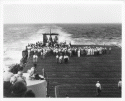
NS020900d |
137k |
TBM-1C Avenger BuNo 46353 pushed off the flight deck after the completion
of the funeral service. |

NS020992 |
160k |
Left to right: Bob Chaffe, Bob Cosgrove, Harry Goodwin, Jerry Crumley, Charlie
Hurd, Walt Harper. All pilots in Torpedo Squadron Fifteen (VT-15). Taken early November 1944 after an awards ceremony, shortly
before the air group left USS Essex (CV-9). Chaffe, Cosgrove, Goodwin and Crumley were
eventually awarded Navy Crosses for action during the Battle of Leyte Gulf, 24–25 October 1944. |
CDR Michael Cosgrove (Ret.), son of Robert D. Cosgrove |

NS0209aa
.PDF file

Get FREE Adobe Reader |
650k |
CAPT Robert D. Cosgrove's Aviators Flight Log Book while he was aboard USS
Essex (CV-9), April–November 1944. |
CDR Michael Cosgrove (Ret.), son of Robert D. Cosgrove |

NS020991 |
507k |
USS Essex (CV-9) refueling from the T2-SE-A1 oiler USS Tallulah
(AO-50) in a heavy sea off Luzon, 9 November 1944.
Note: According to the ships' deck logs, actual date was 7 November. |
Pieter Bakels
John Bakels, via Yu Chu |

NS0209bx |
1.16M |
CDR David McCampbell (see NS0209bu, above) with 34 "kill"
markings on his F6F-5 Hellcat, Minsi III, with an unidentified Sailor. The photo must
have been taken on or after 14 November 1944. |
Bob Canchola, BT, USN (Ret.) |

NS0209ci |
654k |
USS Essex (CV-9), aerial attack on Japanese shipping in Manila
Bay, Philippines, by carrier aircraft. Note the docks and ships burning. Photograph released: 14 November
1944.
Official U.S. Navy photograph, now in the collections of the National
Archives and Records Administration (NARA), # 80-G-272959. |
NARA |

NS020911d |
241k |
On 25 November 1944, USS Essex (CV-9) was off Luzon, 165 miles
east of Manila, sending strikes to enemy airfields and interdicting shipping around the islands. At
1255 two kamikazes singled out Essex. Both were hit by anti-aircraft fire and one
crashed into the sea. The other bomber, identified as a Yokosuka D4Y3 Suisei ("Comet") model
33 (Allied reporting name Judy) and flown by LT Yamaguchi Yoshinori, kept boring straight in. |
Bob Canchola, BT, USN (Ret.) |

NS020911e |
483k |
USS Essex (CV-9) about to be hit by a Japanese Judy aircraft
during Kamikaze attacks off Luzon, 25 November 1944. The plane, afire from anti-aircraft gun
hits, struck near the carrier's forward elevator. Note Cleveland-class
light cruiser in the left distance. Photographed from USS Ticonderoga (CV-14).
National Archives and Records Administration
(NARA) photo, # 80-G-270738. |
Bob Canchola, BT, USN (Ret.) |

NS020911f |
741k |
A Judy dive bomber about to hit USS Essex (CV-9), 25
November 1944.
National Archives and Records Administration
(NARA) photo, # 80-G-270710. |
Bob Canchola, BT, USN (Ret.) |

NS020911g |
1.77M |
Yokosuka D4Y3 Suisei model 33 (Judy) about to hit USS Essex
(CV-9), 25 November 1944. Pilot was LT Yamaguchi Yoshinori, who was part of the Yoshino Special
Attack Corps and flew from Mabalacat Air Field in the Philippines. Seventeen men lost their lives—the
Japanese pilot and 16 Essex crewmen.
National Archives and Records Administration
(NARA) photo, # 80-G-270649. |
Bob Canchola, BT, USN (Ret.) |

NS020911h |
87k |
LT Yoshinori Yamaguchi's Yokosuka D4Y3 Suisei model 33 (Judy)
in a suicide dive against USS Essex (CV-9), 1256 hours, 25 November 1944. Dive brakes
are extended, the burning non-self-sealing port wing tank of the Suisei is trailing smoke. Note
tail number 17. (Colorized photo.)
Photographed by LCDR Earl Colgrove, USNR.
The plane was not carrying a bomb, but its gasoline exploded, setting fires on the deck and catwalk.
The carrier's flight deck was damaged, along with her Group 4 20mm battery and hangar deck in the area
of the impact. The fires were brought under control and by 1326 Essex was able to resume
flight operations. There was little structural damage. |
Bob Canchola, BT, USN (Ret.) |

NS020911a |
496k |
A Japanese kamikaze hits USS Essex (CV-9)
on 25 November 1944, during naval operations under Admiral Halsey in support of US landings on Leyte.
(See also NS020911.)
Naval History & Heritage Command (NH&HC),
Naval Historical Foundation Collection, Photo
# UA 478.12.01. |
Robert Hurst
Bob Canchola, BT, USN (Ret.) |
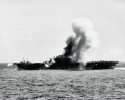
NS020911j |
1.74M |
Bob Canchola, BT, USN (Ret.) |

NS020911i |
421k |

NS015714k |
204k |
USS Essex (CV-9) takes a hit, as seen from USS South
Dakota (BB-57).
"On 25 November 1944, for the first time in her far-ranging operations and destruction to the enemy,
Essex received injury. A kamikaze hit the port edge of her flight deck landing
among planes gassed for takeoff, causing extensive damage, killing [16], and wounding [54]." (Quoted
from DANFS.) |
Pieter Bakels |

NS020911c |
734k |
USS Essex (CV-9) is shown just after being crashed by a Japanese
Kamikaze, 25 November 1944. Essex is camouflaged in Ms. 32/10D and destroyer
USS Prichett (DD-561), left, is wearing
32/13D. This photo was taken from USS South
Dakota (BB-57).
United States National Archives and Records Administration,
Photo No. 80-G-270749. |
Courtesy of C. Lee Johnson, (usndazzle.com),
via Mike Green |
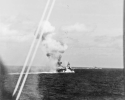
NS020911r |
49k |
USS Essex (CV-9) afire after the Kamikaze attack, 25
November 1944. This photo was taken from USS South
Dakota (BB-57). |
Gerd Matthes, Germany |

NS020911 |
419k |
Japanese Kamikaze aircraft explodes after crashing into the carrier's
flight deck amidships, during operations off the Philippines, 25 November 1944. Photographed from USS
Langley (CVL-27).
Official U.S. Navy Photograph, now in the collections of the National
Archives and Records Administration (NARA), photo # 80-G-273032.
(See also NS020911a.) |
Scott Dyben
Bob Canchola, BT, USN (Ret.) |

NS020911b |
54k |
USS Essex (CV-9), November 1944, following a kamikaze
hit. The ammo cans are visible on the bulkhead inboard of the catwalk.
National Archives photo # 80-G-270718.
(See also NS020911a.) |
Pieter Bakels |

NS020911k |
396k |
USS Essex (CV-9), 25 November 1944. Fire on the flight deck
and in the 20mm battery, resulting from a suicide dive by a Japanese plane. Looking down from island.
USS Langley (CVL-27) can be seen in the background. |
Via Bob Canchola, BT, USN (Ret.) |

NS020911m |
619k |

NS020911n |
534k |

NS020911l |
96k |
Fire-fighters and scattered fragments of the Japanese kamikaze cover
the flight deck of USS Essex (CV-9), 25 November 1944. |

NS020911p |
385k |
USS Essex (CV-9), 25 November 1944. Hole in the flight deck
as a result of a Japanese kamikaze crash. |
Via Bob Canchola, BT, USN (Ret.) |

NS020911o |
663k |
USS Essex (CV-9), 25 November 1944. Repair parties covering
over the hole. Flight operations were resumed a few minutes later. |

NS020911q |
506k |
Side view of damage. |

NS020911s |
100k |
Damage to USS Essex (CV-9) after Kamikaze attack on
25 November 1944. The attack did not stop her and she was soon back in action. |
Gerd Matthes, Germany |

NS0209ck |
442k |
Burial at sea of men killed in the 25 November 1944 kamikaze
attack. |
Via Bob Canchola, BT, USN (Ret.) |

NS0209cka |
601k |
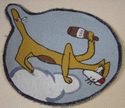
NS0209ay |
47k |
VF-9 "Cat o'Nines/Hellcats" patch. Painted on canvas and made by Max Berman
Costume and Props of Los Angeles for RKO movie studios.
One of the longest-serving fighter squadrons of the war (aboard Ranger,
Essex, Lexington and Yorktown),
VF-9 was also one of the few to engage two enemy powers—Vichy French (Morocco, November 1942,
from Ranger) and Japanese aircraft (March 1943–June 1945; Essex, Lexington
and Yorktown). With 256.75 victories, VF-9 finished the war as the third-ranking FitRon in
the Navy; top scorer was LT Eugene A. Valencia, with 23. |
Tommy Trampp |

NS0209bj |
553k |
The Essex Buccaneer, 8 December 1944. Articles on CAPT Carlos
W. Wieber and CDR David McCampbell. |
Mark Herber |

NS0209bk |
1.60M |
The Essex Buccaneer, Vol. 1, No. 8, 25 December 1944. Christmas issue. |
Mark Herber |

NS020921 |
64k |
Fire aboard USS Essex (CV-9) after an F6F-5P's Hellcat
drop tank burst on landing, 16 December 1944.
National Archives (College Park, MD) photo # 80-G-301346. |
Tracy White, Researcher @ Large |

NS020949 |
86k |
Ship's newspaper logo, circa 1944-1945. |
Steve Whitby |

NS0209di |
810k |
Fuel lines snake across the water between an unidentified fleet oiler and
the aircraft carrier USS Essex (CV-9) during underway replenishment between strike operations,
circa 1944–1945. With the Pacific theater of operations a wide ranging battlefield consisting
of islands surrounded by thousands of square miles of ocean, the ability to replenish the fleet at
sea was necessary to support sustained combat operations. This view is on the starboard side of the
ship, just forward of the island looking aft.
National Naval Aviation Museum photo,
# 1983.046.010.008. |
Mike Green |

NS020956 |
105k |
(Poor quality) photo of a VT-83 TBM heading for a water landing after having
most of its tail shot away, early-mid 1945. Tough bird! |
Steve Whitby |

NS0209cb |
375k |
Multi-language "I am an American aviator" pamphlet, to be used in Southeast
Asia.
"I am an American aviator.
My plane is destroyed.
I cannot speak your language.
I am an enemy of the Japanese.
Kindly protect me, heal me, and lead me to the nearest Allied military office.
The government of my country will reward you." |
Mark Herber |

NS021743 |
203K |
Task Group 58.3, under Rear Admiral Frederick C. Sherman, departs Ulithi
on 10 February 1945. Seen from USS Bunker Hill (CV-17) are USS Cowpens
(CVL-25), left, and USS Essex (CV-9), center.
Task Force 58 conducted attacks against the Tokyo area (16–17, and 25 February) both to neutralize
the enemy's airpower before the landings on Iwo Jima (19 February) and to cripple the aircraft manufacturing
industry. |
Pieter Bakels |

NS020947 |
147k |
Underway, March 1945. By this time she had been repainted into Measure 21
camouflage. |
Steve Whitby |

NS020957 |
133k |
A VB-83 SB2C-4 from Essex, March 1945. |
Steve Whitby |

NS0209bp |
409k |
USS Essex (CV-9) V-3 "Bogeys," 12 March 1945.
(Note, however, that the envelope enclosing the photo gives the date as 11 March 1945.) |
Mark Herber |

NS0209bpa |
482k |

NS020960 |
76k |
Corsairs from VBF-83 flying from the Essex in March of
1945. Essex had the first F4U-1D/FG-1D's deployed on a fleet carrier. Note that the
ship's fighter squadron, VF-83, was equipped with F6F Hellcats. |
Steve Whitby |

NS020948 |
101k |
VB-83's SB2C-4's Helldivers during the Okinawa Invasion, 1 April 1945. |
Steve Whitby |

NS0209by |
110k |
"Captain Hugh N. Batten was born in Huntington, West Virginia on October 17,
1923. He entered the Naval Aviation Cadet program in 1942 and received his wings and commission in December
1943. Batten checked out in F4F Wildcats and F6F Hellcats and in December 1944 joined
Fighting Squadron 83 (VF-83) which would go aboard the USS Essex in early 1945, as a part
of the famed Carrier Task Force 58."
"Batten flew his first combat mission on March 19, 1945 and as the formation passed over Kure Naval
Base 25 to 30 enemy fighters were sighted. Batten and his wingman, Lt. (j.g.) Samuel Brocato, tied into
a formation of Jack fighters and using mutual support tactics managed to down two of them apiece.
His next action came on April 6, 1945 off Okinawa. While on defensive patrol, Batten and his wingman
got into a formation of Zekes headed for the fleet. Using the tactics that had proven so successful
previously, he and his wingman Brocato each downed four of the enemy fighters earning a Navy Cross for
both pilots. Final combat came for Batten and Brocato on July 28th when they teamed to destroy two Tonys
over an airfield in central Kyushu, Japan."
"Hugh Nash Batten was buried at the Arlington National Cemetery, section 64, site 767."
Navy Cross Citation reads: "The President of the United States of America takes pleasure in presenting
the Navy Cross to Lieutenant, Junior Grade Hugh Nash Batten (NSN: 0-326456), United States Naval Reserve,
for extraordinary heroism in operations against the enemy while serving as Pilot of a carrier-based
Navy Fighter Plane in Fighting Squadron EIGHTY-THREE (VF-83), attached to the U.S.S. ESSEX
(CV-9), in action against the enemy on Combat Air Patrol over our Task Force operating in the vicinity
of Okinawa on 6 April 1945. During this flight Lieutenant, Junior Grade, Batten initiated an attack
against nine enemy fighters and shot down four of them. His courage and skill in pressing home an attack
against forces greatly superior in number was at all times in keeping with the highest traditions of
the United States Naval Service." |
Bill Gonyo |

NS020961 |
93k |
A Corsair just about to plow through a wave breaking over the bow with
full flaps, full up elevators and full right rudder. |
Steve Whitby |
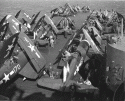
NS0209ai |
84k |
F4U Corsairs and F6F Hellcats of Air Group 83 aboard USS Essex
(CV-9), during the Okinawa Campaign. |
Robert Rocker |

NS0209ak |
167k |
A Marine Corps F4U-1D Corsair comes in for a landing aboard the carrier
USS Essex (CV-9). Photo USN.
From Aircraft
Carriers, by Norman Polmar. |
Robert Hurst |

NS020989 |
50k |
Partial view of USS Essex (CV-9) flight and hangar decks, looking
down elevator shaft. Photo by Paul Madden CPHOM. |
Pieter Bakels |

NS015703q |
693k |
USS South Dakota
(BB-57)—background—firing, as seen from USS Essex (CV-9), during the occupation
of Okinawa. USN photo. |
Pieter Bakels |

NS015701b |
333k |
Anti-aircraft bursts from Task Force 58 as a Japanese plane is hit and explodes
just beyond USS Essex (CV-9), in an action off Okinawa, Ryukyu Islands, 11 April 1945.
Photo taken from USS South Dakota
(BB-57). USN photo. |
Pieter Bakels |

NS020915 |
124k |
USS Essex (CV-9) receiving provisions via highline from
USS Mercury (AK-42) on 27 April 1945, while operating off Okinawa. Essex
crewmen in the foreground are stacking bags of flour. Note man on Mercury's forward
hatch, directing the hoisting of another load from her hold.
Official U.S. Navy Photograph, now in the collections of the National Archives (photo # 80-G-373777).
|
Scott Dyben |

NS0209bw |
161k |
As seen from USS Essex (CV-9), USS Astoria
(CL-90), USS Randolph (CV-15), and other units of Task Force 58 steam in
the Pacific, circa May 1945. Carrier in the background might be USS Bunker Hill
(CV-17). |
Brent Jones,
via Pieter Bakels |

NS020916 |
490k |
Underway at sea during the Okinawa Campaign, 20 May 1945.
Note that her air group contains both F4U Corsair and F6F Hellcat
fighters.
Official U.S. Navy Photograph, now in the collections of the National
Archives and Records Administration (NARA), # 80‑G-373816. |
Scott Dyben
Mark Herber |

NS020990 |
65k |
TBM Avengers and SB2C Helldivers from Essex Air
Group 83 dropping bombs on Hakodate, Japan, July 1945. |
Pieter Bakels |

NS020958 |
91k |
Men of USS Essex posed in front of the ship's scoreboard, mid-1945. |
Photo by LCDR Paul S. Rundall, USN(Ret).
Contributed by his grandson, Ryan Romero |

NS0209au |
132k |
Men of Engineering Department (?), B Division (?), USS Essex
(CV-9). Owen Charles Candler is third from right, front row. |
Linda Candler Hastings, daughter of Owen Charles Candler |

NS0209bt |
5.00M |
Roster of Officers, 22 August 1945. |
Mark Herber |

NS0209br |
4.84M |
The Essex Buccaneer, Vol. 2, Nos. 5 and 6, August
and September 1945. |
Mark Herber |

NS0209co |
143k |
"Information for Passengers," possibly from a Magic Carpet trip. |
Paula Huston for her father Raymond Huston, Yorktown's musician and plank owner.
Via Robert Hall |

NS020959 |
112k |
"Essex-class aircraft carrier." (From a Russian publication).
This drawing shows the appearance of a "short hull" Essex late in the war, with two lattice
radio masts, island structure modified with an extended flag bridge and one quad 40-mm gun mount removed,
and up to 18 quad Bofors gun mounts (16 visible here plus one or two on the bow, hidden by the flight
deck). Essex herself, however, carried her original five lattice radio masts through
the entire war and had no more than eleven 40-mm mounts: one on the bow and one on the stern, one on
each 5" sponson, two on the (never fitted) hangar deck catapult's port side extension, three on the
island and two on the starboard quarter. |
Alex Tatchin |
For more photos and information about this ship, see:
|














































































































































